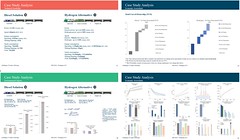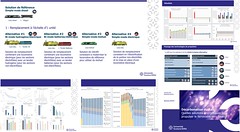I took this photo on 10/16 while driving to my organic chemistry class at PG Community College, Largo campus. The 8 lanes of traffic on I-495 shown here is reflective of our society's dependence on cars, because infrastructure planning prioritizes the use of cars over modes of transportation such as walking, biking, and public transit. UN sustainable development goal #11 focuses on making cities and human settlements inclusive, safe, resilient and sustainable [1]. Meeting this goal includes providing “access to safe, affordable, accessible and sustainable transport systems for all, improving road safety, notably by expanding public transport, with special attention to the needs of those in vulnerable situations, women, children, persons with disabilities and other persons” [2]. Car dependency conflicts with goal 11 because it is a major contributor to greenhouse gas emissions, is expensive, dangerous and exclusionary to the disabled, elderly, and poor.
According to data from the National Highway Traffic Safety Administration, 42,500 people were killed in car crashes in 2022 [3]. Particulate matter, as well as carbon monoxide, nitrogen dioxide and carbon dioxide emitted from automobile tail pipes is a major contributor to air pollution [4]. According EPA data, 16% of all greenhouse gas emissions in the US came from light duty vehicles, or automobiles [5]. According to the Bureau of Transportation Statistics, of people surveyed aged 18-64, about 3.6 million Americans did not leave their house in the previous year due to travel limiting disabilities [6]. Additionally, car dependence isolates the elderly socially, and limits their independence.
Cars are expensive, especially because in almost every part of the country, car ownership is a major factor in one's ability to access services, job opportunities, and social connection. A 2024 study published in the Journal of Planning Education and Research presented findings from interviews with people who had received cars from a nonprofit to examine how having a car impacted their lives. Interviewees explained that after they received a car, their earnings increased, they no longer had to endure long frustrating, and emotionally exhausting commutes, and they had access to better health care [10]. I did not explain this to show that everyone should have a car, but to show how exclusionary car dependency is to those without a car.
Car dependency is at odds with UN SDG 11 because it is expensive for those who own the car, but also for the society as a whole. Per capita resources needed to support the ownership of cars for 87% of households [7], is much higher than it would be if we had robust public transportation systems in cities. Additionally, the cost of road construction and maintenance is paid for by taxes [8], which could be better spent on initiatives that would help us reach UN SDG 11.
Car dependence allows for urban sprawl, in which public transportation becomes inefficient, which leads to reduced funding for public transit, which incentivizes people to buy more cars. Low public transportation use means that there is no reason to prioritize land use around public transport axes [9].
1. UN. (2024, August 6). Goal 11 | Department of Economic and Social Affairs. Retrieved from sdgs.un.org/goals/goal11.
2. UN. (2024, August 6). Goal 11 | Department of Economic and Social Affairs. Retrieved from sdgs.un.org/goals/goal11.
4. Jantti, H., Jonk, S., Budia, M. G., Ohtonen, S., Fagerlund, I., Feroze Fazaludeen, M., & Aakko-Saksa, P. (2024, February 15). Particulate matter from car exhaust alters function of human iPSC-derived microglia - PMC. Retrieved from pmc.ncbi.nlm.nih.gov/articles/PMC10870637/.
3. Automated Vehicles for Safety | NHTSA. (n.d.). Retrieved from www.nhtsa.gov/vehicle-safety/automated-vehicles-safety.
5. EPA . (2024, May). Fast Facts on Transportation Greenhouse Gas Emissions | US EPA. Retrieved from www.epa.gov/greenvehicles/fast-facts-transportation-green....
6. Travel Patterns of American Adults with Disabilities. (2018, September 6). Retrieved from www.bts.gov/newsroom/travel-patterns-american-adults-disa....
7. Carlier, M. (2024, March 11). United States: Car ownership 2023 | Statista. Retrieved from www.statista.com/statistics/1427511/household-car-ownersh....
8. Dutzik, T., & Weissman, G. (2015). Who Pays for Roads? Maryland PIRG Foundation. Retrieved from pirg.org/maryland/foundation/resources/who-pays-for-the-r....
9. Mattioli, G., Roberts , C., Steinberger, J. K., & Brown, A. (2020, August). The political economy of car dependence: A systems of provision approach. Retrieved from www.sciencedirect.com/science/article/pii/S2214629620300633.
10. Klein, N. J. (2020, September 9). Subsidizing Car Ownership for Low-Income Individuals and Households. Retrieved from journals.sagepub.com/doi/pdf/10.1177/0739456X20950428.
























